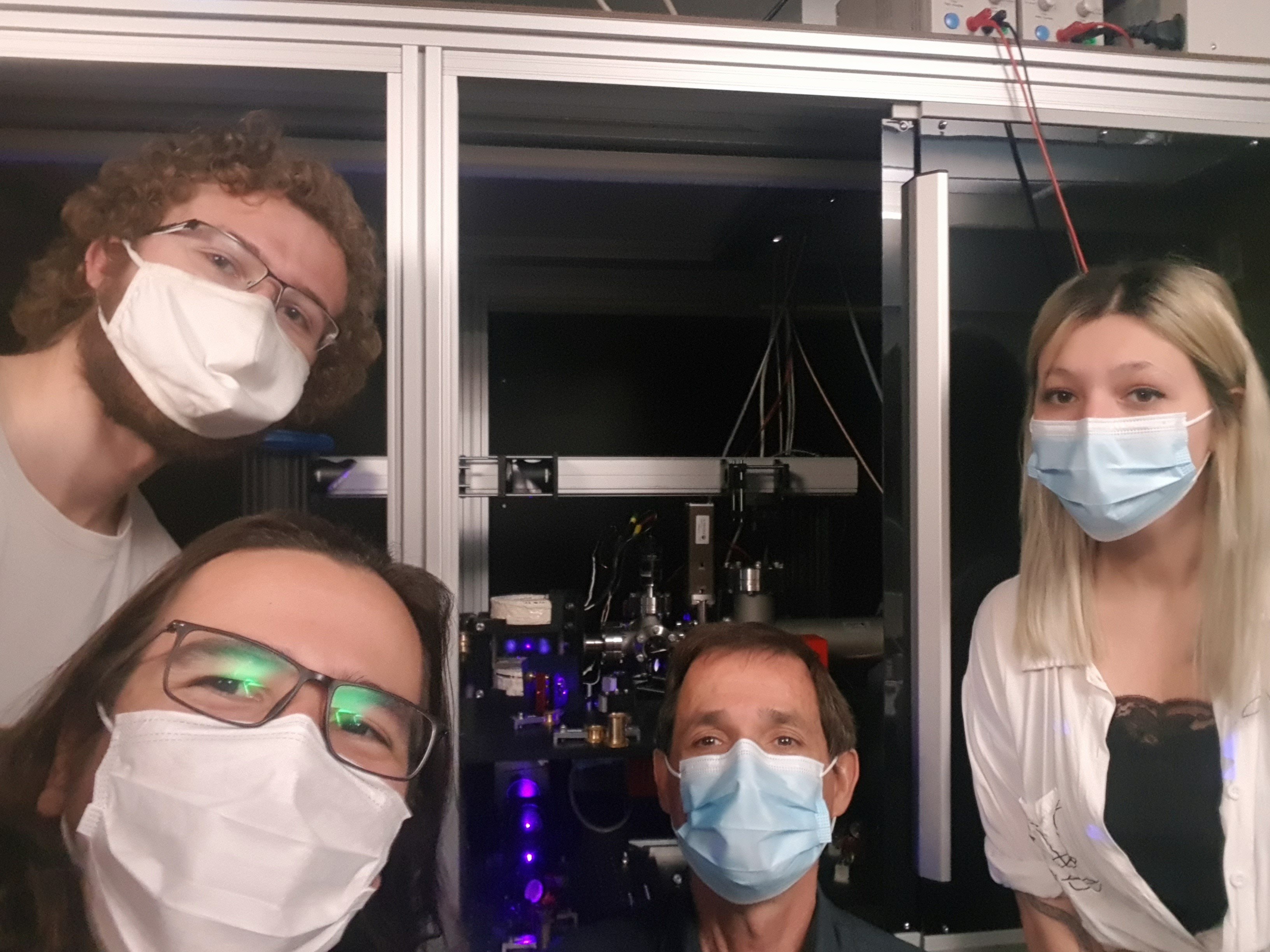ERC project: Anderson Localization Light in Cold Atoms (ANDLICA)
The goal of this project is to use large clouds of cold ytterbium atoms to observe Anderson localization of light in three dimensions, which has challenged theoreticians and experimentalists for many decades.After the prediction by Anderson of a disorder-induced conductor to insulator transition for electrons, light has been proposed as ideal non interacting waves to explore coherent transport properties in the absence of interactions. The development in experiments and theory over the past several years have shown a route towards the experimental realization of this phase transition.
Previous studies on Anderson localization of light using semiconductor powders or dielectric particles have shown that intrinsic material properties, such as absorption or inelastic scattering of light, need to be taken into account in the interpretation of experimental signatures of Anderson localization. Laser-cooled clouds of atoms avoid the problems of samples used so far to study Anderson localization of light. Ab initio theoretical models, available for cold ytterbium atoms, have shown that the mere high spatial density of the scattering sample is not sufficient to allow for Anderson localization of photons in three dimensions, but that an additional magnetic field or additional disorder on the level shifts can induce a phase transition in three dimensions.
The role of disorder in atom-light interactions has important consequences for the next generation of high precision atomic clocks and quantum memories. By connecting the mesoscopic physics approach to quantum optics and cooperative scattering, this project will allow better control of cold atoms as building blocks of future quantum technologies. Time-resolved transport experiments will connect super- and subradiant assisted transmission with the extended and localized eigenstates of the system.
Short video describing the project (in French): https://youtu.be/H1IgWd1WsxQ
People
- Robin Kaiser (PI)
- Raphaël Saint-Jalm (Assistant Professor)
- Daniel Benedicto Orenes (Post-doc)
- Apoorva (PhD student)
- Naudson L. Lopes Matias (PhD student)
- Bérengère Pinoche (PhD student)
Alumni : Antoine Glicenstein (Post-doc, 2023-2024), Álvero de Melo (PhD student, 2020-2024), Hector Letellier (PhD student, 2019-2024), Nahum Chávez (Post-doc, 2021-2022), Anaïs Dorme (Master, 2021)
News & events
October 2024: Bye bye Antoine and welcome to Naudson
Antoine Glicenstein has left the team to start a new post-doc in Berlin: thank you very much for your work and good luck to you!
Simultaneously, we're happy to welcome our new PhD student, Naudson L. Lopes Matias.
January 2024: Welcome to Daniel Benedicto Orenes
Daniel has joined the Yb team as a post-doc with a European Marie Curie fellowship. Before that he graduated from the University of Birmingham (UK) and did a first post-doc at LENS (Italy) and a second post-doc at ICFO (Spain).
September 2023: Welcome to Raphaël Saint-Jalm
Raphaël has been hired by the University as an Assistant Professor, congratulations! He's joining the Yb team after a post-doc in the group of Immanuel Bloch (Garching, Germany) and a PhD thesis in the group of Jean Dalibard (Collège de France, Paris).
February 2023: Welcome to Antoine Glicenstein
Antoine joined the Yb team after completing his PhD thesis in the group of Antoine Browaeys at Institut d'Optique (Palaiseau).
May 2022: Welcome to Apoorva
Apoorva is starting her PhD thesis in our team. She's going to contribute to the experimental work. Before that she did her Master at the Indian Institute of Technology Delhi (India).
At about the same time, Nahum left to go back to Mexico.
Good luck to both of you!
October 2021: Welcome to Nahum Calderón Chávez
Nahum is starting a post-doc in our team. He's going to work on theoretical and numerical aspects of the project. Before that he did his PhD in Puebla (Mexico) and a first post-doc in Bescia (Italy).
Oct. 2021: The ANDLICA webpage is back!
After several months of interruption and the complete loss of data (due to the fire of the data center), the ANDLICA webpage is finally back. But this is still a work in progress...
Experimental work: Construction on a new cold-atom apparatus using ytterbium

Experimental work began during summer 2019 with purchasing equipment and turning an old unused room into an optical lab.
October 2021: We now have two tables full of lasers and optical devices, a vacuum chamber, and laser-cooled ytterbium atoms inside! We obtained our first magneto-optical trap (on the blue transition) in spring 2021.
October 2024: After the move to a new building, a lot of experimental work, two PhD defenses, and many other adventures, our first physics paper has been accepted in Physical Review Letters!
Publications
- Probing subradiant dynamics in cold atomic ensembles via population and emitted light measurements
A. Glicenstein, D. B. Orenes, A. Apoorva, R. Saint-Jalm, R. Kaiser
Preprint: arXiv:2507.16549
- In-situ measurements of light diffusion in an optically dense atomic ensemble
A. Glicenstein, A. Apoorva, D. B. Orenes, H. Lettelier, A. M. G. de Melo, R. Saint-Jalm, R. Kaiser
Phys. Rev. Lett. 133, 233401 (2024), preprint: arXiv:2409.11117
- Laser frequency stabilization by modulation transfer spectroscopy and balanced detection of molecular iodine for laser cooling of 174Yb
A. M. G. de Melo, H. Letellier, A. Apoorva, A. Glicenstein, R. Kaiser
Opt. Express 32, 6204 (2024), preprint: arXiv:2311.08542
- Loading of a large Yb MOT on the 1S0-1P1 transition
H. Letellier, A. M. de Melo, A. Dorne, R. Kaiser
Rev. Sci. Instrum. 94, 123203 (2023), preprint: arXiv:2308.00387
Theoretical work: Towards Anderson localization of light in cold atoms
We are investigating the existence and the conditions of the observability of Anderson localization of light in cold atoms. This work is mainly collaborative, with the groups of Eric Akkermans (Technion, Israel), Luca Celardo (Brescia, then Mexico, now Florence, Italy) and Romain Bachelard (São Carlos, Brazil).Publications
- Nonergodic extendend phase for waves in three dimensions
M. Prado, R. Bachelard, R. Kaiser, F. A. Pinheiro
Preprint: arXiv:2510.20346
- Nonlinear effects in Anderson localization of light by two-level atoms
N. A. Moreira, R. Kaiser, R. Bachelard
Phys. Rev. A 109, L031501 (2024), preprint: arXiv:2311.01632
- Localization of light in three dimensions: A mobility edge in the imaginary axis in non-Hermitian Hamiltonians
G. L. Celardo, M. Angeli, F. Mattiotti, R. Kaiser
Europhys. Lett. 145, 35002 (2024), preprint: arXiv:1702.04506v4
- Roles of cooperative effects and disorder in photon localization: The case of a vector radiation field
L. Bellando, A. Gero, E. Akkermans, R. Kaiser
Eur. Phys. J. B 94, 49 (2021), preprint: arXiv:1906.06966
- Anderson localization of light in dimension d - 1
C. E. Máximo, N. A. Moreira, R. Kaiser, R. Bachelard
Phys. Rev. A 100, 063845 (2019), preprint: arXiv:1909.12269
- Localization vs. subradiance in three-dimensional scattering of light
N. A. Moreira, R. Kaiser, R. Bachelard
Europhys. Lett. 127, 54003 (2019), preprint: arXiv:1905.10442
- Microscopic and macroscopic signatures of 3D Anderson localization of light
F. Cottier, A. Cipris, R. Bachelard, R. Kaiser
Phys. Rev. Lett. 123, 083401 (2019), preprint: arXiv:1812.10313
- Shielding and localization in presence of long range hopping
G. L. Celardo, R. Kaiser, F. Borgonovi
Phys. Rev. B 94, 144206 (2016), preprint: arXiv:1604.07868
- Spatial and temporal localization of light in two dimensions
C. E. Máximo, N. Piovella, P. W. Courteille, R. Kaiser, R. Bachelard
Phys. Rev. A 92, 062702 (2015), preprint: arXiv:1509:00815
- Cooperative effects and disorder: A scaling analysis of the spectrum of the effective atomic Hamiltonian
L. Bellando, A. Gero, E. Akkermans, R. Kaiser
Phys. Rev. A 90, 063822 (2014), preprint: physics/1409.1675
- Subradiant hybrid states in the open 3D Anderson-Dicke model
A. Biella, F. Borgonovi, R. Kaiser, G. L. Celardo
Europhys. Lett. 103, 57009 (2013), preprint: physics/1304.5451
- Quantum Multiple Scattering
R. Kaiser
J. Mod. Opt. 56, 2082 (2009), preprint : physics/1003.2503
- Photon localization and Dicke superradiance in atomic gases
E. Akkermans, A. Gero, R. Kaiser,
Phys. Rev. Lett. 101, 103602 (2008), preprint : cond-mat/0806.0941


